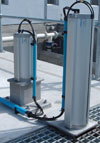

The current skills shortage is making plant automation increasingly important, but this often requires skilled personnel to maintain and repair the equipment. However, with the correct design and a few basic steps, the complexity can be minimised.
Firstly, the equipment should be simple in design to enable easy inspection and change. This also empowers less skilled labour to perform general tasks on the equipment with some training.
Secondly, reliable remote diagnostics should be installed for fault finding. This has the benefit of using scarce skilled labour more effectively. Remote diagnostics also feed back important information for preventive maintenance programmes to function effectively.
Thirdly, the working components should be close to the application and the brains of the operation should be centralised. This ensures that the controlling components are kept in a safe working environment and are protected from accidental mechanical damage during day-to-day operations.
Festo recently commissioned a portion of Kleinbrak, a 15 Ml/day water treatment plant, where these design principles were followed and achieved through electro-pneumatic control. Starting with the air supply, a piston type compressor was used with a primary and standby compressor pump to ensure reliability of supply through redundancy. The air cleaning units followed a dual stage process, removing 40 μm and 5 μm dust particles to ensure longevity of the pneumatic equipment. A refrigeration drier was installed to remove water and ensure the system stayed relatively condensate free.
The air reticulation system was designed to ensure the airlines angled towards a single drainage point for condensation. The lines were constructed from a maintenance-free UV and corrosion-resistant polyamide.

The valve terminal was situated in a central yet easily accessible control cabinet close to the main air reticulation line. The valve terminal communicated directly with the PLC through a single multicore cable using fieldbus transmission. The valve was capable of collecting and transmitting remote I/O data and in the same terminal could activate the pneumatic actuators using onboard solenoid valves for each process valve in the required sequence. The system was completely modular and had the added benefit of built-in diagnostics. This design and construction principle ensured that the terminal could be maintained and repaired with ease. It also assisted with fault finding and data collection via a single bus system.
To control the flow rate of raw water coming into the plant, a completely integrated linear actuator was used to operate the sluice gate. The actuator required a single air supply and a four-core cable for power and a 4-20 mA signal. The actuator had an IP 75 rating and all the controlling components were housed inside. This reduced external mechanical connections and ensured longevity and reliable functionality.
By using electro-pneumatics for this project, Festo achieved the following:
* Simplified design and installation through centralisation of the valve terminals.
* Minimal complexity through modularity and technologically advanced equipment.
* Improved performance monitoring of equipment through reliable diagnostics.
* Longevity and high corrosion protection in corrosive outside conditions.
* More effective management of scarce, skilled operating and maintenance labour.
* Empowerment of lesser skilled personnel involved in the day-to-day operation and maintenance of the plant.
For more information contact Joanne Dexter, Festo, +27 (0)11 971 5560, [email protected], www.festo.com
| Tel: | 0860 033 786 |
| Email: | [email protected] |
| www: | www.festo.co.za |
| Articles: | More information and articles about Festo |

© Technews Publishing (Pty) Ltd | All Rights Reserved